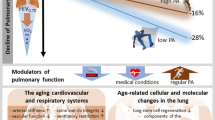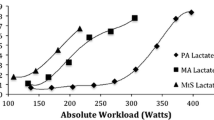Abstract
Purpose
Aerobic training accelerates Heart Rate Recovery after exercise in healthy subjects and in patients with coronary disease. As shown by pharmacological autonomic blockade, HRR early after exercise is dependent primarily on parasympathetic reactivation. Thus, accelerated HRR early after exercise in endurance-trained athletes may be attributed to augmented parasympathetic reactivation. In the present study, we tested the hypothesis that the HRR early after submaximal exercise is related to the pre-exercise parasympathetic modulation.
Methods
Thirty endurance-trained athletes (20 males, 50 ± 7 years) and thirty control subjects (20 males, 52 ± 6 years) performed a submaximal exercise on a cyclo-ergometer. Pre-exercise resting short-term heart rate variability (HRV) parameters in time and frequency-domains were correlated with HRR during the first 30 s, 1 and 2 min after cessation of exercise.
Results
We found that HRR was statistically significantly faster in athletes than in controls at all examination time points (p < 0.05). HF, SDNN and RMSSD were statistically significantly higher in athletes than in controls (p < 0.05), but other resting HRV parameters were not statistically different between groups. After 30 s, 1 and 2 min of recovery, HRR correlation with total power, HF, HFnu and RMSSD was positive, while the correlation with LF/HF was negative for small and positive for larger values. The opposite was true for SDNN.
Conclusions
These findings support the hypothesis that HRR early after submaximal exercise is related to resting parasympathetic modulation in the middle-aged subjects. In addition, they suggested an optimal range of HRV for maximal HRR after exercise.



Similar content being viewed by others
References
Cole CR, Foody JM, Blackstone EH, Lauer MS (2000) Heart rate recovery after submaximal exercise testing as predictor of mortality in a cardiovascularly healthy cohort. Ann Intern Med 132:552–555
Lauer MS (2009) Autonomic function and prognosis. Cleve Clin J Med 76(Suppl 2):S18–S22
Darr KC, Bassett DR, Morgan BJ, Thomas DP (1988) Effects of age and training status on heart rate recovery after peak exercise. Am J Physiol 254(2 Pt 2):H340–H343
Sugawara J, Murakami H, Maeda S, Kuno S, Matsuda M (2001) Change in post-exercise vagal reactivation with exercise training and detraining in young men. Eur J Appl Physiol 85:259–263
Javorka M, Žila I, Balhárek T, Javorka K (2002) Heart rate recovery after exercise: relations to heart rate variability and complexity. Braz J Med Biol Res 35:991–1000
Imai K, Sato H, Hori M, Kusuoka H, Ozaki H, Yokoyama H, Takeda H, Inoue M, Kamada T (1994) Vagally mediated heart rate recovery after exercise is accelerated in athletes but blunted in patients with chronic heart failure. J Am Coll Cardiol 24:1529–1535
Task Force of the European Society of Cardiology and the North American Society of Pacing and Electrophysiology (1996) Heart rate variability. Standards of measurement, physiological interpretation, and clinical use. Circulation 93:1043–1065
Evrengul H, Tanriverdi H, Kose S, Amasyali B, Kilic A, Celik T, Turhan H (2006) The relationship between heart rate recovery and heart rate variability in coronary artery disease. ANE 11:154–162
Nunan D, Jakovljević DG, Donovan G, Singleton LD, Sandercock GRH, Brodie DA (2010) Resting autonomic modulations and the heart rate response to exercise. Clin Auton Res 20:213–221
Bosquet L, Gamelin FX, Berthoin S (2007) Is aerobic endurance a determinant of cardiac autonomic regulation? Eur J Appl Physiol 100:363–369
Astrand PO, Kaare R, Dahl HA, Stromme SB (2003) Textbook of work physiology, 4th edn. Human kinetics, Champaign, p 281
Robergs RA, Landwehr R (2002) The surprising history of the “HRmax = 220−age” equation. J Exer Physiol 5(2):1–10
Development Core Team (2009) R: A language and environment for statistical computing. R Foundation for Statistical Computing, Vienna, Austria. ISBN 3-900051-07-0, URL. Available online at: http://www.R-project.org. Accessed February 19, 2013
Westfall PH, Young SS (1993) Resampling-based multiple testing. Wiley, New York
Harrell FE Jr, Lee KL, Pollock BG (1988) Regression models in clinical studies: determining relationships between predictors and response. J Natl Cancer Inst 80(15):1199–1202
Paschoal MA, Polessi EA, Simioni FC (2008) Evaluation of heart rate variability in trained and sedentary climacteric women. Arq Bras Cardiol 90:74–79
Cornelissen VA, Verheyden B, Aubert AE, Fagard RH (2009) Effects of aerobic training intensity on resting, exercise and post-exercise blood pressure, heart rate and heart-rate variability. J Human Hypertens. doi:10.1038/jhh
Jurca R, Church TS, Morss GM, Jordan AN, Earnest CP (2004) 8 weeks of moderate-intensity exercise training increases heart rate variability in sedentary postmenopausal women. Am Heart J 147(5):e21
Boutcher SH, Stein P (1995) Association between heart rate variability and training response in sedentary middle-aged men. Eur J Appl Physiol Occup Physiol 70:75–80
Uusitalo AL, Laitinen T, Väisänen SB, Jordan AN, Earnest CP (2004) Physical training and heart rate and blood pressure variability: a 5-year randomized trial. Am J Physiol Heart Circ Physiol 286:H1821–H1826
Carter JB, Banister EW, Blaber AP (2003) The effect of age and gender on heart rate variability after endurance training. Med Sci Sports Exerc 35:1333–1340
Figuera A, Baynard T, Fernhall B, Carhart R, Kanalay JA (2007) Endurance training improves post-exercise cardiac autonomic modulation in obese women with and without type 2 diabetes. Eur J Appl Physiol 100:437–444
Dewland TA, Androne AS, Lee FA, Lampert RJ, Katz SD (2007) Effect of acetylcholinesterase inhibition with pyridostigmine on cardiac parasympathetic function in sedentary adults and trained athletes. Am J Physiol 293:H86–H92. doi:10.1152/ajpheart.01339.2006
Ohuchi H, Suzuki H, Yasuda K, Arakaki Y, Echigo S, Kamiya T (2000) Heart rate recovery after exercise and cardiac autonomic nervous activity in children. Pediatr Res 47:329–335
Lee M, Mendoza A (2012) Dissociation of heart rate variability and heart rate recovery in well-trained athletes. Eur J Appl Physiol 112:2757–2766
Buchheit M, Simon C, Charloux A, Doutreleau S, Piquard F, Brandenberger G (2006) Relationship between very high physical activity energy expenditure, heart rate variability and self-estimate of health status in middle-aged individuals. Int J Sports Med 27:697–701
Chen JY, Lee YL, Tsai WC, Lee CH, Chen PS, Li YH, Tsai LM, Chen JH, Lin LJ (2011) Cardiac autonomic functions derived from short term heart rate variability recordings associated with heart rate recovery after treadmill exercise test in young individuals. Heart Vess 26(3):282–288
Armstrong RA, Eperjesi F, Gilmartin B (2005) The use of correlation and regression methods in optometry. Clin Exp Optom 88(2):81–88
Rahimi K, Thomas A, Adam M, Hayerizadeh BF, Schuler G, Secknus MA (2006) Implications of exercise test modality on modern prognostic markers in patients with known or suspected coronary artery disease: treadmill versus bicycle. Eur J Cardiovasc Prev Rehabil 13(1):45–50
Hayano J, Mukai S, Sakakibara M, Okada A, Takata K, Fujinami T (1994) Effects of respiratory interval on vagal modulation of heart rate. Am J Physiol 267(1 Pt 2):H33–H40
Hatfield BD, Spalding TW, Santa Maria DL, Porges SW, Potts JT, Byrne EA, Brody EB, Mahon AD (1998) Respiratory sinus arrhythmia during exercise in aerobically trained and untrained men. Med Sci Sports Exerc 30(2):206–214
Conflict of interest
On behalf of all authors, the corresponding author states that there is no conflict of interest.
Author information
Authors and Affiliations
Corresponding author
Electronic supplementary material
Below is the link to the electronic supplementary material.
Rights and permissions
About this article
Cite this article
Danieli, A., Lusa, L., Potočnik, N. et al. Resting heart rate variability and heart rate recovery after submaximal exercise. Clin Auton Res 24, 53–61 (2014). https://doi.org/10.1007/s10286-014-0225-2
Received:
Accepted:
Published:
Issue Date:
DOI: https://doi.org/10.1007/s10286-014-0225-2




